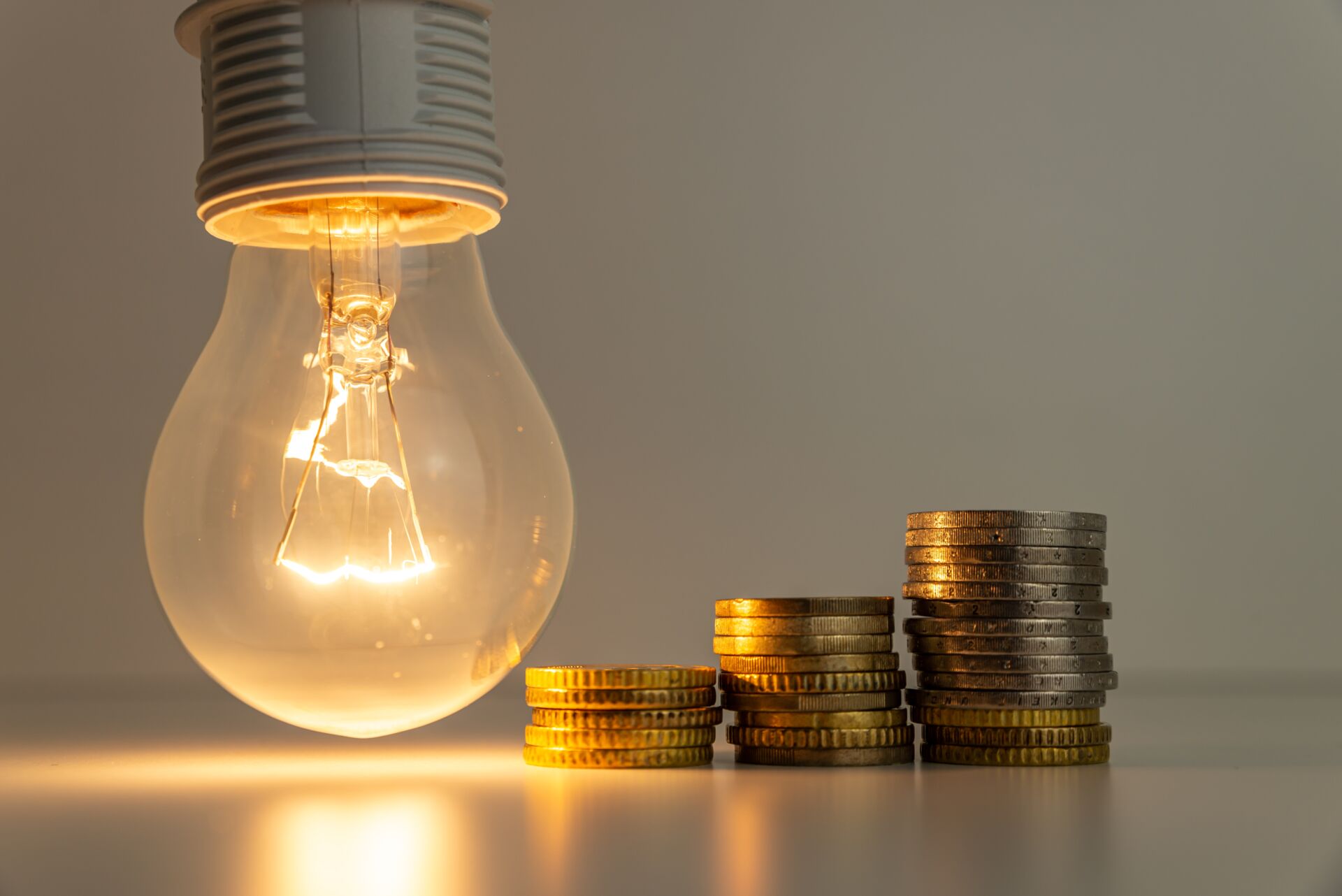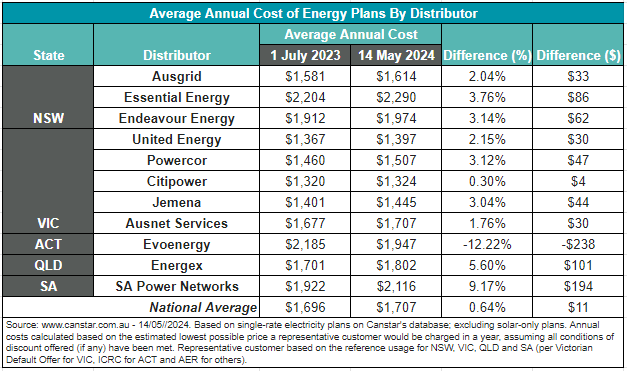More than 10 million Australian households will receive a new $300 relief payment toward their energy bills under measures outlined in the Federal Budget 2024-25, as Canstar Blue data showed that average annual electricity costs had flattened nationally since July 2023.
A $325 payment will be made to one million small businesses too, as part of an expansion to the government’s Energy Bill Relief Fund program. In its first iteration in 2023-24, the $1.5 billion fund covered five million low-income and pensioner households with a payment of $50, as well as one million eligible small businesses.
Treasurer Jim Chalmers said the government would spend $3.5 billion on the payments announced in the May 14 budget for 2024-25, doubling the number of households eligible for relief. We’ve explained who will get a payment, how the payments will work and what it means for average energy bills.
Who gets the $300 energy bill relief payment?
All households that pay an energy bill will receive the $300 payment. This means that households that pay more than one energy bill because, for example, they own a second property, will receive two payments.
Households that get energy from an embedded network, such as those in some apartment buildings, caravan parks and retirement villages, will need to apply to their state or territory government to receive the payment. The government said information on how to make these applications would be available before July 1.
Questioned about whether it was reasonable to provide energy bill relief to households on high incomes, Mr Chalmers told Sunrise on May 15 that the most efficient way of distributing the payments – via energy providers – meant that it wasn’t possible to identify bill-payers by their household income. Providers’ systems could only identify pensioners among their customers, he said.
“Once you go beyond [pensioners] you have to design a whole new system because the energy retailers that we use to provide this help, they don’t have income information for people,” the treasurer said.
How will the $300 energy bill relief payment work?
The energy bill relief payment will be paid directly to energy providers, which will apply the payments to householders’ quarterly bills at a rate of $75 per quarter. There’s no requirement to apply for the payment, which will be applied from July 1, unless your household energy is supplied via an embedded network.
The payments will be in addition to state and territory governments’ energy bill relief payments that have been announced separately. This month the Queensland Government said it would make a new $1,000 payment to all Queenslanders to offset higher energy costs, while the WA Government said it would provide a $400 payment to the state’s residents.
The payments will also be in addition to state and territory energy bill rebates and concessions provided to pensioners and other eligible householders. Find out if you’re eligible for a rebate or concession on your energy costs.
Canstar Blue research conducted in December 2023 on average electricity bills around Australia found that Tasmanians paid the highest average quarterly energy bills, at $372 in their most recent quarter, while West Australians paid the lowest bill, at $296.
If you’d like more information on lower-cost energy plans and the latest switching deals in your location, you can check out the following Canstar Blue guides:
- Current energy switching deals and promotions
- The cheapest electricity plans in South East Queensland
- The cheapest electricity plans in New South Wales
- The cheapest electricity plans in Victoria
- The cheapest electricity plans in South Australia
- The cheapest electricity plans in Western Australia
- The cheapest electricity plans in the ACT
Compare energy deals
Here are some sponsored deals from the retailers on our database that include a link to the retailer’s website for further details. These are products from referral partners†. These costs are based on the Ausgrid energy network in Sydney but prices may vary depending on your circumstances. This comparison assumes general energy usage of 3900kWh/year for a residential customer on a single rate tariff. Please use our comparison tool for a specific comparison in your area and to see other products in our database that may be available. Our database may not cover all deals in your area. As always, check all details of any plan directly with the retailer before making a purchase decision.
|
9% Less than reference price |
$1,651 Price/year (estimated) |
Go to Site |
Here are some sponsored deals from the retailers on our database that include a link to the retailer’s website for further details. These are products from referral partners†. These costs are based on the Citipower network in Melbourne but prices may vary depending on your circumstances. This comparison assumes general energy usage of 4000kWh/year for a residential customer on a single rate tariff. Please use our comparison tool for a specific comparison in your area and to see other products in our database that may be available. Our database may not cover all deals in your area. As always, check all details of any plan directly with the retailer before making a purchase decision.
 |
|
15% Less than VDO |
$1,238 Price/year (estimated) |
Go to Site |
Here are some sponsored deals from the retailers on our database that include a link to the retailer’s website for further details. These are products from our referral partners†. These costs are based on the Energex network in Brisbane but prices may vary depending on your circumstances. This comparison assumes general energy usage of 4600kWh/year for a residential customer on a single rate tariff. Please use our comparison tool for a specific comparison in your area and to see other products in our database that may be available. Our database may not cover all deals in your area. As always, check all details of any plan directly with the retailer before making a purchase decision.
 |
|
9% Less than reference price |
$1,888 Price/year (estimated) |
Go to Site |
Here are some sponsored deals from the retailers on our database that include a link to the retailer’s website for further details. These are products from our referral partners†. These costs are based on the SA Power network in Adelaide but prices may vary depending on your circumstances. This comparison assumes general energy usage of 4011kWh/year for a residential customer on a single rate tariff. Please use our comparison tool for a specific comparison in your area and to see other products in our database that may be available. Our database may not cover all deals in your area. As always, check all details of any plan directly with the retailer before making a purchase decision.
 |
|
9% Less than reference price |
$2,036 Price/year (estimated) |
Go to Site |
What other energy bill help was in the Budget 2024-25?
The budget provided almost $48 million to be spent over the next three years on other indirect energy-related consumer initiatives, which aren’t described in depth in the budget papers but include:
- “Priority consumer energy resources reforms” to cut energy bills by increasing the supply of renewable energy to the electricity grid from residential solar and batteries
- Funding for the Australian Energy Regulator to upgrade its systems, maintain regulatory activities and “deliver better outcomes for consumers” via the Energy Made Easy website
- “Energy retail reform measures” to help householders get a better deal through easier switching and access to rebates and concessions, cuts to fees and charges and addressing the automatic rollover onto higher-priced plans when a consumer’s energy contract ends.
Are Australian electricity bills rising or falling?
In his commentary around the budget, Mr Chalmers said that the latest energy bill relief payment meant that household bills will be 17 per cent lower on average nationally in 2024-25 compared to the previous year.
“In the year to the March quarter 2024, electricity prices rose 2%, and would have risen 14.9% without our energy bill rebates,” he said in reference to the first tranche of Energy Bill Relief Fund payments that were made in 2023-24.
Canstar Blue research found that the average annual cost of an electricity plan varied considerably depending on location and the energy distribution network when comparing prices at the start of this financial year, on July 1, 2023, and the date of the budget announcement on May 14, 2024. These plan prices don’t take into account the impact of energy bill relief payments or rebates residents may have received.
For example, the average annual cost of an electricity plan on the Australian Capital Territory’s Evoenergy network fell 12.22% or $238 when the two dates are compared, while the average annual cost on South Australia Power Networks had risen 9.17% or $194.
In the larger states, New South Wales saw the average annual cost rise by as much as 3.76% or $86 and Victoria experienced price rises of up to 3.12% or $47. Queensland’s Energex network had an average annual plan price rise of 5.6% or $101.
The national average annual cost was near-flat at 0.64% or $11.
You can see how average annual electricity plan prices have changed in your state or territory in this table.
Compare cheap electricity plans in your state
Here are some of the cheapest published deals from the retailers on our database that include a link to the retailer’s website for further details. These are products from referral partners†. These costs are based on the Ausgrid network in Sydney but prices may vary depending on your circumstances. This comparison assumes general energy usage of 3900kWh/year for a residential customer on a single rate tariff. Please use our comparison tool for a specific comparison in your area. Our database may not cover all deals in your area. As always, check all details of any plan directly with the retailer before making a purchase decision. Here are some of the cheapest published deals from the retailers on our database that include a link to the retailer’s website for further details. These are products from referral partners†. These costs are based on the Citipower network in Melbourne but prices may vary depending on your circumstances. This comparison assumes general energy usage of 4000kWh/year for a residential customer on a single rate tariff. Please use our comparison tool for a specific comparison in your area. Our database may not cover all deals in your area. As always, check all details of any plan directly with the retailer before making a purchase decision. Here are some of the cheapest published deals from the retailers on our database that include a link to the retailer’s website for further details. These are products from referral partners†. These costs are based on the Energex network in Brisbane but prices may vary depending on your circumstances. This comparison assumes general energy usage of 4600kWh/year for a residential customer on a single rate tariff. Please use our comparison tool for a specific comparison in your area. Our database may not cover all deals in your area. As always, check all details of any plan directly with the retailer before making a purchase decision. Here are some of the cheapest published deals from the retailers on our database that include a link to the retailer’s website for further details. These are products from referral partners†. These costs are based on the SA Power network in Adelaide but prices may vary depending on your circumstances. This comparison assumes general energy usage of 4000kWh/year for a residential customer on a single rate tariff. Please use our comparison tool for a specific comparison in your area. Our database may not cover all deals in your area. As always, check all details of any plan directly with the retailer before making a purchase decision.
Image credits: Daniele Mezzadri/shutterstock.com





Share this article